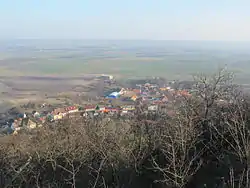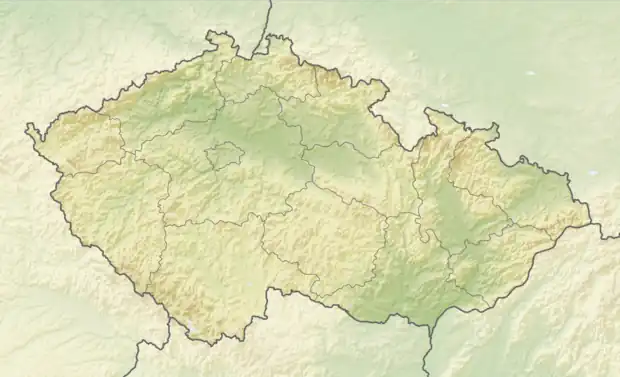Chožov | |
|---|---|
 View from the northwest | |
 Flag  Coat of arms | |
 Chožov Location in the Czech Republic | |
| Coordinates: 50°23′56″N 13°51′33″E / 50.39889°N 13.85917°E | |
| Country | |
| Region | Ústí nad Labem |
| District | Louny |
| First mentioned | 1057 |
| Area | |
| • Total | 21.28 km2 (8.22 sq mi) |
| Elevation | 225 m (738 ft) |
| Population (2023-01-01)[1] | |
| • Total | 561 |
| • Density | 26/km2 (68/sq mi) |
| Time zone | UTC+1 (CET) |
| • Summer (DST) | UTC+2 (CEST) |
| Postal codes | 439 22, 440 01 |
| Website | www |
Chožov (German: Koschow) is a municipality and village in Louny District in the Ústí nad Labem Region of the Czech Republic. It has about 600 inhabitants.
Administrative parts
The villages of Mnichovský Týnec and Třtěno are administrative parts of Chožov.
Geography
Chožov is located about 6 kilometres (4 mi) northeast of Louny and 32 km (20 mi) southwest of Ústí nad Labem. It lies on the border between the Central Bohemian Uplands and Lower Ohře Table. The highest point is at 388 m (1,273 ft) above sea level. The northwestern half of the municipality is situated in the České středohoří Protected Landscape Area.
History
The first written mention of Chožov (originally named Chodžov) is from 1057, when Duke Spytihněv II donated the village to the Litoměřice Chapter.[2]
Demographics
|
|
| ||||||||||||||||||||||||||||||||||||||||||||||||||||||
| Source: Censuses[3][4] | ||||||||||||||||||||||||||||||||||||||||||||||||||||||||
Sights
The main landmark is the prayer house of the Czechoslovak Hussite Church with the rectory, built in the Historicist style in 1924. It is one of the earliest buildings of this church and still serves its original purpose.[5]
References
- ↑ "Population of Municipalities – 1 January 2023". Czech Statistical Office. 2023-05-23.
- ↑ "Dějiny Chožova" (in Czech). Obec Chožov. Retrieved 2023-11-20.
- ↑ "Historický lexikon obcí České republiky 1869–2011 – Okres Louny" (in Czech). Czech Statistical Office. 2015-12-21. pp. 3–4.
- ↑ "Population Census 2021: Population by sex". Public Database. Czech Statistical Office. 2021-03-27.
- ↑ "Sbor a fara Církve československé husitské" (in Czech). National Heritage Institute. Retrieved 2023-11-20.